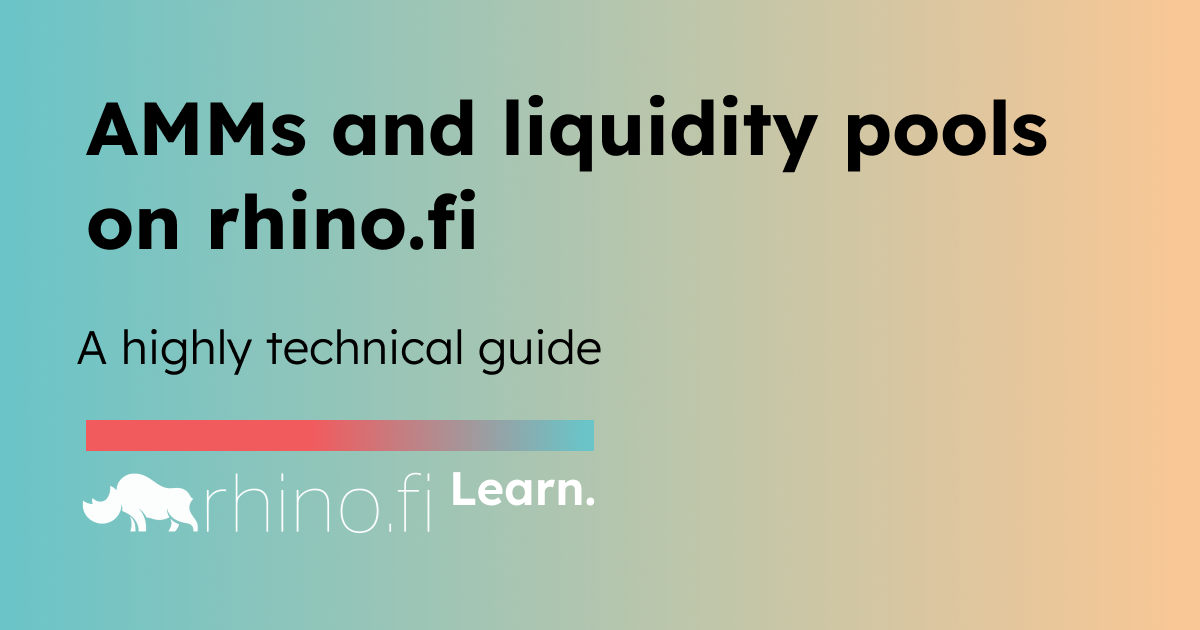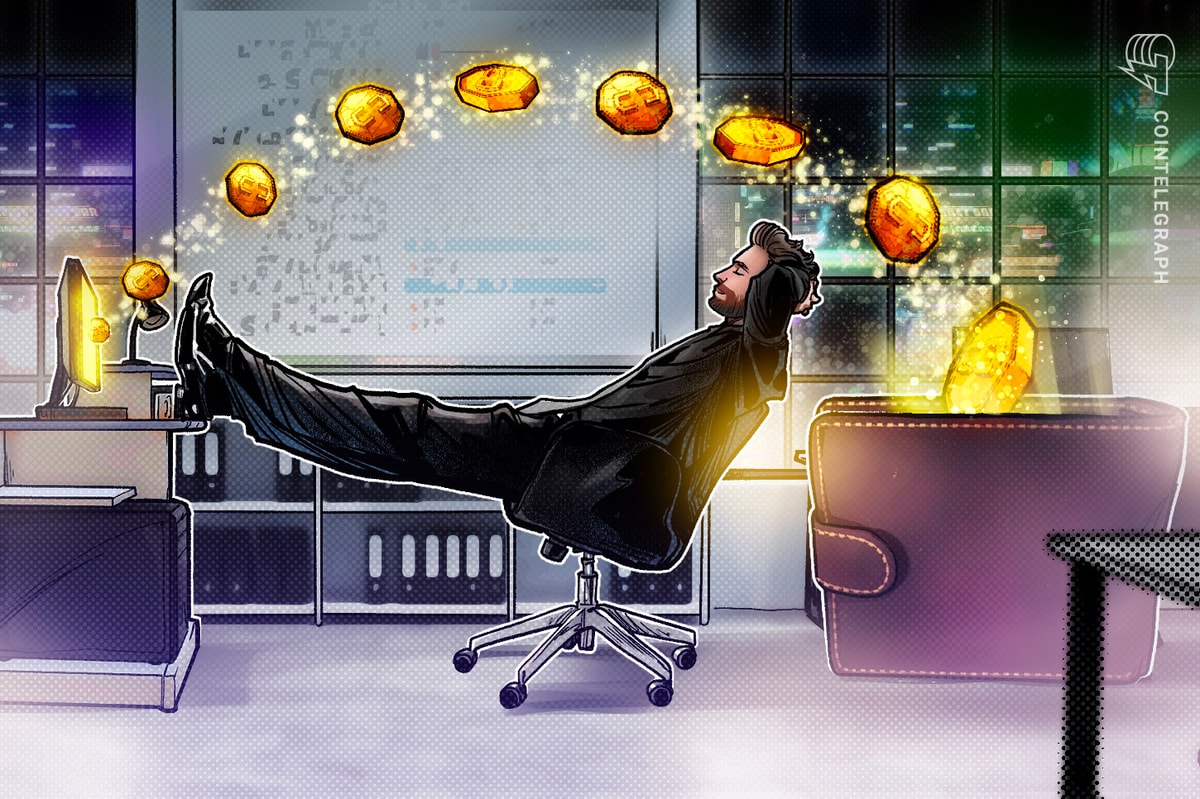Liquidity providers can only contribute to pools by providing token pairs of equal value.
This doesn’t mean the same amount of each token, but rather a ratio that corresponds to the pool’s holdings. For example, if a pool holds 1,000 DVF and 1 ETH, participants will need to supply 1,000 DVF for every 1 ETH.
When tokens are deposited, liquidity providers receive the LP token, which represents their share of the pool. This token can be traded on DEXs and earn further rewards for providing liquidity.
What makes rhino.fi’s AMMs unique
To enable AMMs, rhino.fi has developed smart contracts based on UniSwap V2. These contracts operate on Layer 1 and are dedicated to synchronizing token balances between Layer 2 and Layer 1. Trading is disabled on these contracts, serving solely as a means of balance synchronisation.
Typically, these contracts allow anyone to create a market by depositing two tokens. However, rhino.fi currently disables this feature to maintain control over market creation.
LP token minting occurs periodically on Layer 1 in batches. The synchronization between StarkEx and the Layer 1 contract utilises a feature called L1 Orders, introduced in StarkEx version three. L1 Orders facilitate periodic synchronization between Layer 1 and Layer 2.
This synchronisation ensures that tokens from Layer 2 are sent to Layer 1, and the corresponding LP tokens are minted according to the AMM map. It guarantees that LP tokens represent genuine shares of the pool, preventing the creation of LP tokens out of thin air. This process is handled atomically and instantaneously.
When trading begins, rhino.fi switches the AMM contracts to Layer 2 mode, meaning assets cannot be traded on Layer 1. Transactions must take place off-chain.
An exception to this is emergency withdrawals. In the event of rhino.fi or StarkEx being offline, liquidity providers can use an emergency withdrawal feature to retrieve their funds from the Layer 1 contract using their LP tokens.
The pricing mechanism behind rhino.fi’s AMMs and liquidity pools
rhino.fi currently employs a pricing mechanism based on the classic UniSwap curve. However, the implementation of the L1 contract allows for the addition of different pricing mechanisms in the future, such as those tailored for stablecoin pools, simply by adjusting the code.
Trusted or Custodial Elements
The entire AMM process on rhino.fi is self-custodial for both traders and liquidity providers, relying on user signatures.
When users trade against the AMM, they sign a form specifying their desired token, the acceptable price, and the maximum allowable slippage. They receive the requested asset if the swap meets the specified terms; otherwise, the swap does not occur, and they retain their original token. This guarantee mirrors that of any other trading market on rhino.fi.
Similarly, when liquidity providers deposit assets into the pool, they receive the correct amount of LP tokens. In cases where a deposit fails due to significant changes in the token ratio during the deposit process, the original assets are returned in the correct ratio.
While rhino.fi theoretically has the ability to deny user requests to swap, burn, or mint tokens due to the Layer 2 nature of the platform, a feature is being developed to address this. It will enable users to express their desire to burn LP tokens on Layer 1, similar to the guarantees offered by the StarkEx contract itself, compelling the contract to release all funds. More information will be provided in the future.
Risk Factors
Trading and providing liquidity in AMMs carry similar risks to any contract that controls users’ funds, including the risk of hacks.
rhino.fi takes extensive precautions to minimize these risks, implementing thorough internal audits and undergoing regular external audits from leading blockchain security experts such as PeckShield. Unnecessary changes are avoided whenever possible.
Another risk factor applicable to all AMM pools in DeFi is “impermanent loss.” This term refers to the opportunity cost resulting from significant changes in token value on the open market.
Liquidity pools and AMMs create an isolated ecosystem, where token prices are solely influenced by trading within the pool. The algorithm does not consider external information. As a result, token prices may experience more substantial increases on regular DeFi exchanges compared to AMM pools.
Arbitrage traders may take advantage of the difference in value by buying tokens from the AMM pool. This reduces the supply of that token compared to the other asset in the pool.
When liquidity providers want to withdraw, they receive a proportionate amount of tokens based on the available supply at that time. They may end up with more of the ‘less valuable’ token and less of the ‘more valuable’ one because arbitrage traders bought the higher-value token from the pool and sold the lower-value one.
As a result, liquidity providers might have been better off holding both assets instead of depositing them into the pool because they now have a relatively smaller quantity of the more valuable token.
This loss is called impermanent because it is theoretical and only becomes permanent if the user chooses to exit the pool. Trading fees earned through LP tokens can help offset these losses, but it’s not guaranteed.
For further discussion on our AMM and liquidity pool process or any other aspect of rhino.fi’s technology, please reach out to us on Twitter or Discord.
Read More: rhino.fi









 Bitcoin
Bitcoin  Ethereum
Ethereum  Tether
Tether  XRP
XRP  Solana
Solana  USDC
USDC  Dogecoin
Dogecoin  TRON
TRON  Cardano
Cardano  Lido Staked Ether
Lido Staked Ether  Wrapped Bitcoin
Wrapped Bitcoin  Sui
Sui  Hyperliquid
Hyperliquid  Wrapped stETH
Wrapped stETH  Chainlink
Chainlink  Avalanche
Avalanche  Stellar
Stellar  Bitcoin Cash
Bitcoin Cash  Toncoin
Toncoin  LEO Token
LEO Token  Shiba Inu
Shiba Inu  USDS
USDS  Hedera
Hedera  Monero
Monero  WETH
WETH  Litecoin
Litecoin  Wrapped eETH
Wrapped eETH  Polkadot
Polkadot  Binance Bridged USDT (BNB Smart Chain)
Binance Bridged USDT (BNB Smart Chain)  Ethena USDe
Ethena USDe  Bitget Token
Bitget Token  Pepe
Pepe  Pi Network
Pi Network  WhiteBIT Coin
WhiteBIT Coin  Coinbase Wrapped BTC
Coinbase Wrapped BTC  Dai
Dai  Aave
Aave  Uniswap
Uniswap  Bittensor
Bittensor  Ethena Staked USDe
Ethena Staked USDe  Cronos
Cronos  OKB
OKB  Aptos
Aptos  NEAR Protocol
NEAR Protocol  BlackRock USD Institutional Digital Liquidity Fund
BlackRock USD Institutional Digital Liquidity Fund  Jito Staked SOL
Jito Staked SOL  Ondo
Ondo  Internet Computer
Internet Computer  Ethereum Classic
Ethereum Classic